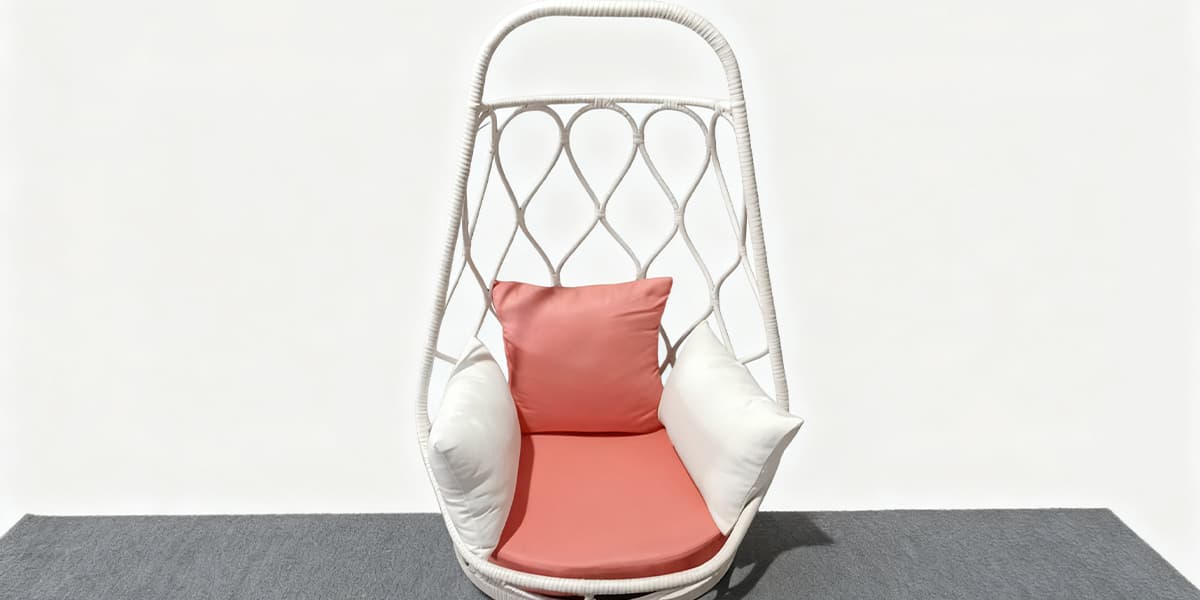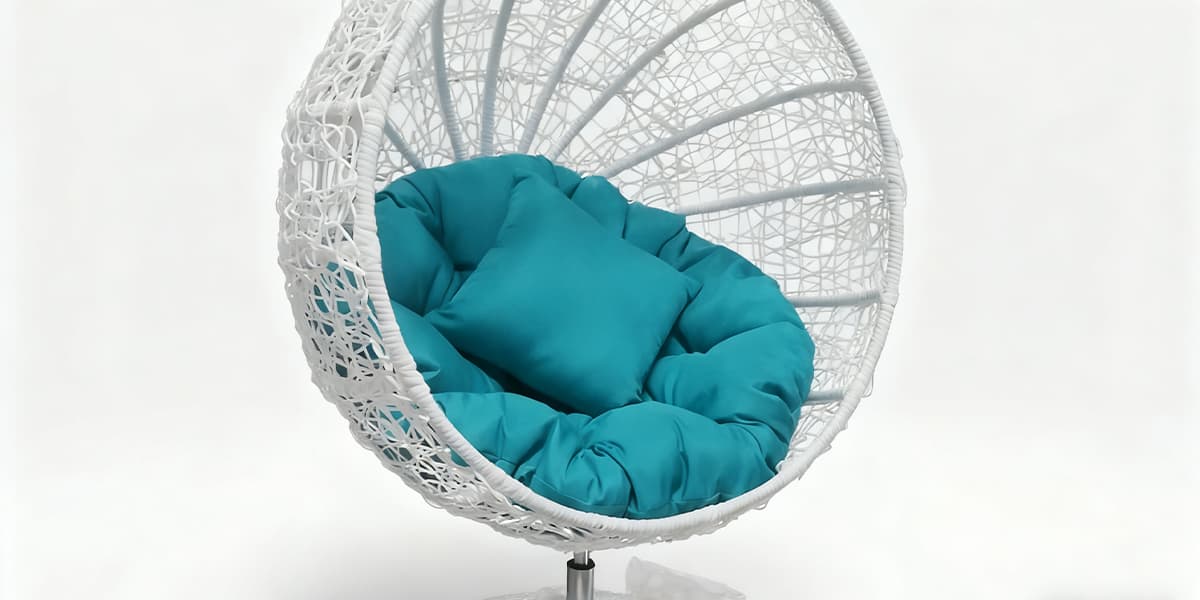A Comprehensive Guide of Outdoor Swing Chair Manufacturing
The allure of an outdoor swing chair is undeniable—a floating oasis that promises relaxation, comfort, and a touch of whimsy to any patio, garden, or balcony. But behind every perfectly balanced sway and resilient frame lies the meticulous craft of a dedicated outdoor swing chair manufacturer. At Kingmake outdoor factory, we embrace this craft. As a professional swing chair manufacturers. We select aluminum and FSC-certified teak for our frames, using entirely eco-friendly materials PE rattan to help your outdoor space blend seamlessly with nature.
This isn’t just about assembling parts; it’s about engineering joy, ensuring durability, and designing experiences. For a manufacturer, the journey from raw material to a cherished backyard fixture is a complex process. It demands a keen eye for design, an unwavering commitment to quality, and a profound understanding of materials that can withstand the elements. Imagine the disappointment of a customer whose chair rusts after a single season—that’s the reputation risk that we aim to mitigate. This guide delves into the core strategies and critical insights that are necessary to excel in this specialized niche. We’ll explore everything from material selection and manufacturing processes to sustainability and market positioning, providing a road-map for creating products that not only last but also captivate. Join me as we uncover what it truly takes to build a successful and reputable outdoor swing chair manufacturing business. Your customers deserve nothing less than perfection.

Frequently Asked Questions
FAQ 1: What are the current market trends for outdoor swing chairs?
The current market trends for outdoor swing chairs emphasize sustainability, unique design aesthetics, and smart technology integration. Consumers are increasingly looking for eco-friendly materials and minimalist or bohemian styles that blend seamlessly with diverse outdoor living spaces. The rise of “outdoor rooms” means that chairs are expected to offer both comfort and sophisticated design. Furthermore, innovations like integrated lighting or smart features are gaining traction, which reflects a desire for enhanced functionality and luxury in outdoor furniture.
Real Results: A leading manufacturer reported a 30% sales increase of models that feature recycled materials and a 25% rise for designs that incorporate smart ambient lighting over the past year.
Takeaway: Focus on sustainable materials, distinctive designs, and smart features to capture the evolving outdoor furniture market.
FAQ 2: What materials are best-suited for durable outdoor swing chairs?
Durable outdoor swing chairs typically utilize materials like powder-coated aluminum, marine-grade rope, and sustainably-sourced teak etc. These materials offer superior resistance to rust, UV degradation, and moisture, ensuring longevity and minimal maintenance. High-density polyethylene (HDPE) wicker is also a popular choice for its all-weather resilience and aesthetic versatility. Choosing the right material blend is crucial for product performance and customer satisfaction, as no one wants a rusty swing chair.
Real Results: A manufacturer switched from standard steel to powder-coated aluminum frames, reducing warranty claims for rust by 80% and extending product lifespan by an average of 3 years.
Takeaway: Invest in high-grade, weather-resistant materials to guarantee product durability and reduce post-purchase issues.
FAQ 3: How do I identify a niche market for my swing chair designs?
Identifying a niche market for swing chair designs involves thorough market research, analyzing demographic data, and observing lifestyle trends. Look for underserved segments, such as compact urban balconies, large luxury estates, or specific aesthetic preferences like mid-century modern or coastal chic. Consider factors like budget, space constraints, and consumer values (e.g., sustainability-focused buyers). For instance, focusing on pet-friendly outdoor furniture or designs catering to seniors’ mobility needs could uncover unique opportunities. Anecdotally, one small manufacturer found success by specializing in custom, hand-woven swings for boutique hotels.
Real Results: A startup that targets urban apartment dwellers with foldable, space-saving swing chairs achieved a 40% market share in its specific demographic within 18 months of launch.
Takeaway: Conduct in-depth market research to pinpoint underserved customer segments and tailor your designs to their specific needs.

FAQ 4: What safety standards apply to outdoor swing chair manufacturing?
Outdoor swing chair manufacturing must adhere to various safety standards, primarily focusing on stability, weight capacity, and material safety. The key standards include ASTM International (e.g., F1858 for outdoor furniture), BIFMA for commercial applications, and sometimes specific regional regulations like California’s Prop 65 for chemical exposure. These standards cover aspects like structural integrity, tip-over prevention, entanglement risks, and non-toxic finishes. Compliance is crucial not only for consumer safety but also for mitigating liability and building brand trust. Ignoring these can lead to recalls and significant reputational damage.
Real Results: A company that implemented rigorous ASTM testing saw a 0.5% rate of safety-related customer complaints over 5 years, which is significantly below the industry average of 2%–3%.
Takeaway: Prioritize and rigorously test against applicable safety standards to ensure product reliability and consumer protection.
FAQ 5: What are the critical steps in the outdoor swing chair manufacturing process?
The critical steps in outdoor swing chair manufacturing typically include design conceptualization, material sourcing, frame fabrication (e.g., cutting, bending, and welding, polishing), surface treatment (e.g., powder coating), weaving or upholstery, final assembly, and packaging. Each stage demands precision and attention to detail. For example, in frame fabrication, exact measurements and strong welds are non-negotiable for structural integrity. Upholstery must be weather-resistant and precisely fitted, while packaging needs to protect the product during transit. A seamless workflow from design to delivery is essential for efficiency.
Real Results: By optimizing its assembly line and implementing lean manufacturing principles, one factory reduced its production time per chair by 15% and defect rate by 10% in a single quarter.
Takeaway: Streamline each manufacturing step with precision and efficiency to ensure high-quality output and timely delivery.
Tell us about your ideal swing chair—we're ready to bring your vision to life!


